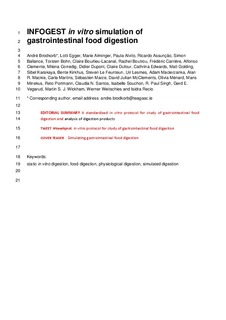| dc.contributor.author | Brodkorb, André | |
| dc.contributor.author | Egger, Lotti | |
| dc.contributor.author | Alminger, Marie | |
| dc.contributor.author | Alvito, Paula | |
| dc.contributor.author | Assunção, Ricardo | |
| dc.contributor.author | Ballance, Simon | |
| dc.contributor.author | Bohn, Torsten | |
| dc.contributor.author | Bourlieu-Lacanal, Claire | |
| dc.contributor.author | Boutrou, Rachel | |
| dc.contributor.author | Carrière, Frédéric | |
| dc.contributor.author | Clemente, Alfonso | |
| dc.contributor.author | Corredig, Milena | |
| dc.contributor.author | Dupont, Didier | |
| dc.contributor.author | Dufour, Claire | |
| dc.contributor.author | Edwards, Catharina | |
| dc.contributor.author | Golding, Matt | |
| dc.contributor.author | Karakaya, Sibel | |
| dc.contributor.author | Kirkhus, Bente | |
| dc.contributor.author | Le Feunteun, Steven | |
| dc.contributor.author | Lesmes, Uri | |
| dc.contributor.author | Macierzanka, Adam | |
| dc.contributor.author | Mackie, Alan R. | |
| dc.contributor.author | Martins, Carla | |
| dc.contributor.author | Marze, Sébastien | |
| dc.contributor.author | McClements, David Julian | |
| dc.contributor.author | Ménard, Olivia | |
| dc.contributor.author | Minekus, Mans | |
| dc.contributor.author | Portmann, Reto | |
| dc.contributor.author | Santos, Cláudia N. | |
| dc.contributor.author | Souchon, Isabelle | |
| dc.contributor.author | Singh, R. Paul | |
| dc.contributor.author | Vegarud, Gerd Elisabeth | |
| dc.contributor.author | Wickham, Martin S. J. | |
| dc.contributor.author | Weitschies, Werner | |
| dc.contributor.author | Recio, Isidra | |
| dc.date.accessioned | 2019-11-20T12:04:39Z | |
| dc.date.available | 2019-11-20T12:04:39Z | |
| dc.date.created | 2019-03-19T10:04:09Z | |
| dc.date.issued | 2019 | |
| dc.identifier.citation | Nature Protocols. 2019, 14 991-1014. | |
| dc.identifier.issn | 1754-2189 | |
| dc.identifier.uri | http://hdl.handle.net/11250/2629497 | |
| dc.description.abstract | Developing a mechanistic understanding of the impact of food structure and composition on human health has increasingly involved simulating digestion in the upper gastrointestinal tract. These simulations have used a wide range of different conditions that often have very little physiological relevance, and this impedes the meaningful comparison of results. The standardized protocol presented here is based on an international consensus developed by the COST INFOGEST network. The method is designed to be used with standard laboratory equipment and requires limited experience to encourage a wide range of researchers to adopt it. It is a static digestion method that uses constant ratios of meal to digestive fluids and a constant pH for each step of digestion. This makes the method simple to use but not suitable for simulating digestion kinetics. Using this method, food samples are subjected to sequential oral, gastric and intestinal digestion while parameters such as electrolytes, enzymes, bile, dilution, pH and time of digestion are based on available physiological data. This amended and improved digestion method (INFOGEST 2.0) avoids challenges associated with the original method, such as the inclusion of the oral phase and the use of gastric lipase. The method can be used to assess the endpoints resulting from digestion of foods by analyzing the digestion products (e.g., peptides/amino acids, fatty acids, simple sugars) and evaluating the release of micronutrients from the food matrix. The whole protocol can be completed in ~7 d, including ~5 d required for the determination of enzyme activities. | |
| dc.description.abstract | INFOGEST static in vitro simulation of gastrointestinal food digestion | |
| dc.language.iso | eng | |
| dc.title | INFOGEST static in vitro simulation of gastrointestinal food digestion | |
| dc.type | Peer reviewed | |
| dc.type | Journal article | |
| dc.description.version | acceptedVersion | |
| dc.source.pagenumber | 991-1014 | |
| dc.source.volume | 14 | |
| dc.source.journal | Nature Protocols | |
| dc.identifier.doi | 10.1038/s41596-018-0119-1 | |
| dc.identifier.cristin | 1685787 | |
| dc.relation.project | Norges forskningsråd: 262300 | |
| cristin.unitcode | 192,12,0,0 | |
| cristin.unitname | Kjemi, bioteknologi og matvitenskap | |
| cristin.ispublished | true | |
| cristin.fulltext | postprint | |
| cristin.qualitycode | 2 | |
